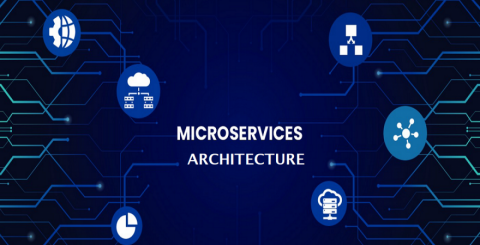5 Key Uses Of Microservices Software Development Architecture

Many features of an application are being split up into independent services with a single purpose for each service, which is an increasingly recent trend in software development. Microservices architecture is the precise term to describe this modular approach to software design.
Employing a Microservices architecture is a novel strategy for software development that has been captivating giant firms. These businesses will replace their traditional monolithic application design with a new framework built on a collection of several loosely connected services.
With boosted flexibility and time-effectiveness in the spotlight, this creative concept of application development has already offered numerous enterprises substantial perks that have helped them expand their enterprises. In this blog, let’s initially understand what Microservices architecture is and then explore its key uses.
Microservices Architecture - The Definition
A software development paradigm that supports the designing, development, and maintenance of complex systems is the Microservice architecture. Microservice applications will function as standalone apps despite being made up of several separate services. End users shall interact with them in a similar way as with monolithic programs, and they seem unaware of the underlying architecture, which may be divided into a monolithic or Microservices code base.
Five Key Uses of Microservices Development
Enterprises shouldn't be afraid to introduce Microservices Software Development into their firms, even though the adoption level has to achieve additional milestones. Here are five key uses of a Microservices architecture that show how it's advantageous to your firm.
1) Effectively Increases Productivity
Code is not the only aspect of the sole responsibility concept. It involves making sure that each part of your company operates as effectively as possible. Since every component of your firm serves a distinct purpose, it is easier to pick what should be included or left out. Concentrating on a single issue and solving it properly can get you moving.
The development crew could divide the code into more manageable chunks thanks to the Microservices architecture. It boosts your application's productivity and resilience. When compared to monolithic apps, the Microservices design makes it simpler for you to implement new features or issue patches. Since they are designed in a modular way, it is simple to update one service at a time without impacting other services that are operating concurrently.
Enterprises offering software development services could also deploy various services independently so that if any problems arise with one of them, it won't affect the others all at once.
2) Extreme Scalability Assuring Continuity of Performance
Scalability is one of the well-known uses, among other noteworthy advantages. Comparatively speaking, monolithic apps are more difficult to scale than Microservices. It's easier and wiser to add additional implementations of a Microservice—and just that service—as needed when you need extra capacity.
Don’t be concerned about Microservices interfering with one another while scaling up or down because they don't share data services or storage. The program doesn't depend on a single codebase, making horizontal service scaling simpler. A standalone Microservice can also be divided into multiple teams and managed separately. It enables one team to work on brand-new features while another team patches flaws in earlier Microservice versions.
As a result, you may expand your enterprise instantly by adding supplement resources as needed without compromising its current operation. A Microservice may be operated in several instances on various servers, which lessens the strain on each server and improves the overall flexibility of your application or website.
3) Enhanced Resilience
Firms have recently had to contend with a barrage of cyberattacks and security. Using a Microservices-based design can help in constructing apps that are more secure and robust. Every service is less susceptible to attack than a huge software system since every Microservice has a significantly smaller surface area and volume than a large system. Instead of using shared data services or storage, services talk to each other using APIs.
Rather than rebuilding whole programs, handle them by simply changing APIs when outdated ones lose importance or new risks emerge. Fault isolation is possible with a Microservices design, which may speed up recovery. You can restart a single service without impacting others if it fails. It implies that you may bounce back from outages more rapidly, reducing the impact on your enterprise and lowering downtime.
4) Technology and Scripting Language Agnostic
Programmers can use any language to connect Microservices when building an application based on Microservices. They must ensure that everyone is using endpoints and APIs for communication. Because everything is managed at the API level, it doesn't matter what technologies have been employed to create a service if it has to be modified or replaced with a new one.
Technical developers can operate on several projects concurrently and in parallel without worrying about whether they will be compatible when they are finished. Microservice architecture has several drawbacks, but programmers may easily fix them by using best practices.
5) Continual Delivery Promotes Quicker Updates
Many enterprises appreciate Microservices because they can rapidly and easily develop little building blocks that can be distributed to consumers. You may evaluate a feature's functionality before expanding its rollout using these relatively small releases, and you can save time by avoiding dealing with many large, complicated deployments at once. Since it enables you to divide your code into distinct services that you can easily update separately, Microservices architecture is beneficial in continuous integration.
New updates can be released more easily, and more critically, they can be rolled back if something goes wrong. It entails that you may update one service without being concerned about how it would affect others. Microservices also enable businesses to concentrate on their core competencies rather than becoming mired down by infrastructure-related problems. Also, they let suppliers of software development work on certain features and then deploy them independently of one another.
In fact, many businesses focused on marketing analytics rely heavily on such architecture to continuously roll out feature upgrades and data processing modules independently.
Wrapping Up
In summary, the Microservices architecture enables the creation of compact, autonomous services that may be separately expanded and upgraded, resulting in a more adaptable architecture. Since it makes code more reusable and extendable, it is also simpler to manage. Also, it makes it possible for features to be delivered continuously and without any obstacles.
Similar Articles
A rapidly growing number of companies are realizing the importance of a robust architectural foundation as they strive to become adaptive digital enterprises.
In today's fast-paced digital world, the success of a business site often hinges on how well it engages users. The online experience determines whether visitors stay, explore, and eventually convert into loyal customers. This is where UI/UX design services play a critical role.
Businesses today operate in an environment where cost efficiency and data sovereignty top the list of important things to a company.
Building a website has never been easier, thanks to modern website builders and hosting solutions. Gone are the days when you needed to hire a web developer or learn complex coding languages to create a professional-looking website.
Launching a WordPress Website is a nightmare, especially if you are non-techie. But guess what, with the right tools, planning, and expert help, it is way easier than you think.
Your systems still “work.” They run critical operations, house years of business data, and your team knows them inside out. But they weren’t built for today — let alone tomorrow.
If you are a new event planner running a WordPress website, you might feel overwhelmed with all the plugins and addons that are out there when managing events.
Did you know that projections indicate a burgeoning 22% surge in demand for full-stack developers by 2025? In the swiftly evolving technological paradigm, businesses require agile and proficient teams to navigate the complexities of modern web development
Web apps are becoming necessary for companies in many different fields. From banking services to e-commerce sites, companies use web-based tools to engage consumers and expedite processes









